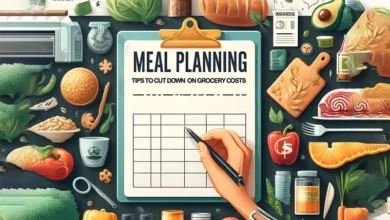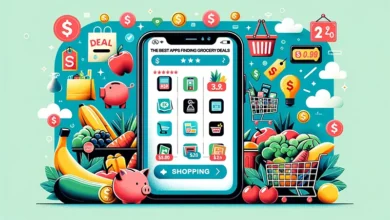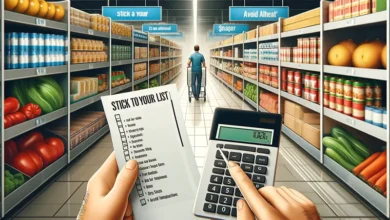How to Create a Grocery List That Saves You Money

We have all been there, standing in the grocery store and looking over all the things we can buy while not remembering what were here to do actually.
Suddenly, your cart is full, and the bank account has a lighter feel.
By recent study, the average American household spends north of $5,000 a year on groceries.
But what if we told you that out of setting up a really simple grocery list, you could very easily save hundreds—if not thousands—of dollars every year?
It’s about time you do some strategic grocery shopping.
Real disorders in spending are impulse buying, overbuying, and food waste when one goes shopping for groceries without a shopping list.
The idea is that a good grocery list will put you in absolute control of spending, trim wastage of food, and, finally, save you some money.
This article is the guideline for coming up with a cost-effective grocery list aligned with your budget and dietary needs.
Be Sure About Your Grocery Needs
Review Your Expenses
It is only after you clearly know what you have been spending on that you can be able to draw up an effective list that you will shop with.
Pause for a minute and go through your grocery receipts for over one or two months.
This will tell you clearly what you are spending on and what trends you are following while spending your amount.
Needs and Wants
Not all edibles are important. Staple foods tend to come in the way of fruits, veggies, grains, proteins, and dairy items, where foodie finds, convenience and prepackaged foods, and pricier cuts of meat tend to be part of the latter.
Consider Diet Needs
But do not forget to beware of the specific diet needs in case somebody from a family member has a gluten-free, veggie, or an allergen diet.
This helps in avoiding unnecessary contingency shopping and ensures that you have within reach the exact set of ingredients.
Diet Plan
Meal Planning on a Budget
Well, one good way of cutting costs in the grocery list is to actually plan what you are going to consume throughout the week.
In this regard, since you will have every item you need, this will prevent you from buying in an impulse.
Planning your meal will also help you resist the temptation up the alley when eating out, which will save you plenty of money.
Include Flexible Ingredients
Just keep in mind these potential meal savers as you plan your menu for the week: Grilling a few extra chicken breasts that you can throw on a salad or stir-fry, or into a casserole, later in the week will save both money and food from going to waste.
Seasonal Produce
Buying in-season items not only keeps your budget happy but allows you to have the freshest products with the most flavor.
Check your local farmers market or your grocery store ad to make some plans with the produce that is currently in season.
Batch Cooking
Bulk cooking saves time and is very economical. The more food that has been cooked in bulk which is put into the freezer, the more cost- and time-effective it is.
Prepare a Shopping List
Inventory Verification
Take an inventory of your pantry, refrigerator, and freezer before you even make a list.
This would help eliminate purchasing of those products that you most probably will already have, thus helping reduce unproductive expenditure and put a myriad of foods to use.
Categorize Your List
With your list broken into categories like produce, dairy, meat, and canned goods, you can pretty much breeze through the store, not going to one end of the isle just to find you left something off your list at the opposite end.
Staples First
So, while making a list, write these important items that you use quite a lot, followed by rice, pasta, bread, eggs, and milk.
Make sure that you are well stocked up on your daily necessities so that you don’t have to rush to the store every day.
Avoid Processed Foods
While convenient, such food items generally eat up a significant portion of your grocery budget.
That’s because processed food generally is much more expensive than the whole food versions of those items are.
Quite often, they’re also not as nutrient dense either.
By reducing the amount of processed foods that you purchase, you’re both saving money and getting healthier at the same time.
Some Wise Shopping Strategies
Price Comparison
Don’t assume that the store you go to regularly has the lowest prices.
Use all the smartphone apps and websites available to compare price points at any number of stores in your local community.
This one simple step can help you lock in on the deals and save you a lot of money.
Buy in Bulk
You will naturally buy in bulk for such non-perishable items that you are a regular consumer of.
Discounts on buying in bulk are given in most stores and warehouse outlets.
Just be sure that you are not forgetting in calculating the storage place and the best-before dates.
Store Brands vs. Name Brands
Don’t assume that because it’s not a name brand, it’s not as good; most of the time, store brand items are just as good and much cheaper.
Taste tests might be in order on some items, but find store brands you like after researching and make a mental note to purchase those instead of their more expensive counterparts.
Coupons and Discounts
Use all coupons, loyalty programs, and sales available.
The majority of the grocery stores have moved to electronic coupons, where they offer coupons through their online platforms. This enables the customer base to access such rewards conveniently.
Furthermore, there are also loyalty program that enable other bonuses and discounts.
Try Not to Buy Impulsively
If you don’t want your money to go down the drain quickly, you must avoid spending impulsively. This can be done by following the lists that you make at the start of the month. Eventually keeping you safe from buying check out treats and buying impulsively from other fancy displays.
Personalize Your Shopping Trips
Shop with a Full Stomach
We all realize that when hungry, the trip to the grocery store will result in poor choices and overspending.
You should already have eaten a good meal or snack before you left so you won’t be forced by hunger to pick up an impulse buy.
Avoid the Rush Hours
Shopping at peak hours can be very exasperating and makes one spend beyond their means.
Even crowded stores and long lines cause one to make quick decisions with impulse buying.
Where possible, try shopping at other hours rather than peak ones to have the store less crowded so that you can have your time.
Honour the List
Make that list of groceries, well thought out, and stick with it. Resist those urges, and don’t leave the list to add any unnecessary stuff in your cart, which can derail very quickly any good, hard work you planned.
Pay in Cash
While it is extremely convenient nowadays to just swipe your debit or credit card, sometimes having cash really does control your spending. Being used to only having a certain set amount of money to bring with you consequently may make one prone to not overspend and be much more cautious about the purchases.
Tips After Purchase
Storage Done Right
Proper food storage is key to making groceries last and preventing waste.
Learn about best practices for storing all kinds of foods, from keeping your fruits and veggies in your crisper drawer to caring for things like meats and dairy to make them last.
Preparation
It is always nice to prepare for meals that you are going to have. This will help in saving time during the week and will enable you in taking your groceries for longer runs.
Look Out for Waste
It is inevitable to avoid food wastage, but you can always try reducing it.
In fact, more so than the other tips, keeping an eye on what goes into the trash causes the least amount of waste—you can identify patterns and then change up your grocery list accordingly.
Example: if you find that you almost always throw away wilty greens, learn some new ways to use them up or get a smaller quantity next time.
Measure and Evaluate
Review Your Spending
Periodically, review grocery spending and take note of areas in which there may be overspending, and more savings could be realized.
This possibly all comes out in the form of patterns: a recurring purchase that might be reduced or taken out completely.
Customize List
Adjust your grocery list as needed based on your review of where your money is going.
If you consistently have leftovers or find you actually end up throwing most of something away, cut them from your list or cut down your purchases.
On the other side, if you keep running out of groceries, you may want to change your purchase patterns and buy more.
Flexibility
It is also important to be lively and flexible.
Your food and cravings might change with time and similarly, you might lose some cravings and liking of food, this will eventually decrease or change your budget allocation for purchasing groceries.
SUMMARY
Developing an inexpensive grocery list—easy, yet powerful—is one of the most powerful ways to get real, on-the-ground control of your household budget and cut down on wasteful spending.
Of course, money that could be saved runs into hundreds, if not thousands of dollars a year, by planning meals strategically based on what you need, efficient shopping, trip optimization, and reevaluation and adjustment.
Remember, frugal food spending means keeping your shopping in mind, being thriftier, making informed choices that support your financial goals, and diet preferences.
So go ahead and apply these strategies from today itself and see your grocery bill shrink and savings grow.
Share your tips and experiences with us in the comments!
FAQs
How many money do I need to put towards food/groceries weekly?
Your food budget will vary with household size, dietary preferences, and location.
As a rough guideline, USDA suggests ranges from $53 to $117/week for a single adult, depending upon the desired food plan (thrifty, low-cost, moderate-cost, or liberal).
Does meal planning really save me money?
Certainly, meal planning can help you save money on groceries.
Planning meals in advance will help you have ingredients when expected, hence reducing last-minute purchases and impulse buying.
Meal planning could also help in the wiser use of the ingredients in a way that is saving money in the long run from wastage.
Is buying generic or store brand products a good idea?
Now will they?
Very frequently, store brand, or generic, products offer the same quality as their name-brand competitors for a fraction of the cost.
Taste tests and ingredient comparisons may result in the products you’ll tolerate, and you could well save a small fortune.
How to Save on Fruits and Vegetables
Produce that is in season is always easier on the pocket. Check out the local farmers markets or even get into the community-supported agriculture programs for local and inexpensive fruits and veggies.
Does it pay to buy in bulk?
It is also possible that this, in turn, could turn out to be a great deal for those often-used non-perishable goods: cereals, canned, and even these important house necessities like toilet paper.
However, one should take keen interest to ensure that they have enough storage space for the same, so that the bulk items bought do not go to waste through expiration.
Below are some tips and strategies to be adopted in making a grocery list that will save money, streamline your shopping, reduce waste, and promote good eating habits.
Happy shopping!




